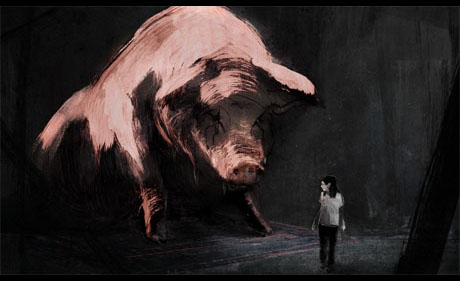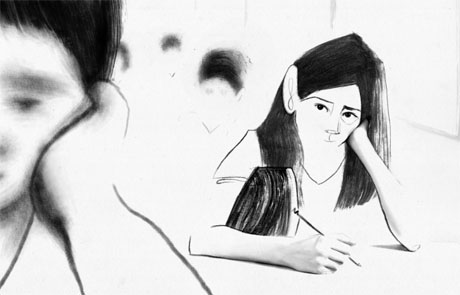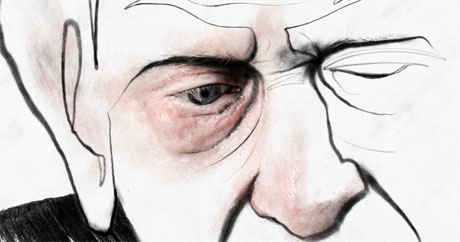
Letter to a Pig is about a guest speaker in a classroom recalling a traumatic event and a female student who becomes immersed in the story. In this Animation Scoop Q&A, director Tal Kantor takes me through how she made one of this year’s 15 finalists for the Best Animated Short Film Oscar. (This Email Interview was edited for length and clarity.)
Jackson Murphy: This is an intense, impactful story. What element did you want to focus on first?
Tal Kantor: In the “Letter to a Pig” development phase, I recognized the necessity for multiple layers and elements to express the story’s complexity. My foremost focus was the emotional plot axis. I wanted to craft this film so above all it will be an emotional journey that enables a universal connection with each character — the survivor, the girl, and the pig. This way, the viewer can feel how one memory unfolds, as each one of the characters holds a different angle on the same story.

JM: How did you want to stage the classroom scene?
TK: I wanted the classroom scene to feel very realistic, almost documentary-like, while at the same time directing it through the subjective point of view of the film’s heroine, the schoolgirl Alma. I aimed to highlight her sensitive character, showcasing what captures her attention, what lingers in her memory from this moment in class, and how her imaginative dreamy nature enables her to process reality. Haim the survivor, who represents the past, is the only speaker in this scene. My goal was to shift the focus towards Alma and the children, directing attention not solely towards those recounting the past but to those silently absorbing these heavy narratives in the classroom, as they represent the future.
JM: What were the challenges of mixing animation with real body parts and the letter?
TK: Well, there were surely quite a few interesting challenges, but it is impossible to list them all here. I think the main one was that this special animation technique requires in fact a kind of production of two films in one film – shooting and editing a live footage film and also a complete production of an animated film frame by frame. It’s a long and multi-step process. The challenge was then to manually combine all the components together (the line animation, the paint animation on the paper, and the photography parts) and blend them carefully in a way that feels organic and uniform in each single frame.

JM: How did you approach the surreal-looking third act?
TK: The story of the film rolls three times and passes between three worlds: memory, reality, and the subconscious world – that is the third act. I wanted this third act of the film to be a different cinematic experience than the first two acts, as this is the non-verbal part where the images, symbols, voices, and movements are the ones that lead the plot. It was based on moments from my original dream (that inspired the film) and in the rest I let my emotions and subconscious guide me. I wanted this part to feel like a dream experience, where there is confusion and broken elements that mix memory and imagination. It was like building a cinematic architecture of the subconscious with the inner surreal logic of a dream. I treated it like a journey to the depths of the soul, which is getting narrower and dives into the young collective memory where our deepest fears are repressed.
JM: What did you want to say about trauma and memories?
TK: I saw my personal local experience as an opportunity to examine a more universal and human issue that interested me — the ways trauma can echo from one generation to the next, and the social and personal implications this transmission has on future generations. How do these stories and memories shape their moral outlook on themselves, others, and the world? I wanted to resonate these thoughts on the screen and ask, among other things: Can we learn and talk about past traumas without transmitting them to future generations? Can we remember, while choosing a different path? Above all, in the end, it was important for me that the film will offer a different angle on how we treat our traumas, with the possibility for healing and hope for more compassion.

JM: What has this pig (and its symbolism) meant to you?
TK: The pig is a fascinating and intelligent animal that is surrounded by different myths, religious beliefs and cultural connotations around the world, which are often negative, such as its impurity according to the Jewish faith. I found the pig to be an interesting symbol to show, among other things, the complex and volatile way in which people see and perceive the “other”. That’s why, in the film, the pig changes its form and role according to how the characters learned or chose to see it – as good, as bad, as a savior, as an evil monster, as an innocent creature. The pig embodies the inheritance of traumatic narratives, biases and prejudices that we automatically project on others. It is there to reflect back to us deep questions about ourselves.
JM: How would you feel about receiving an Oscar nomination?
TK: It would be such a great honor! Indicating that there is a potential for complex and nuanced messages to reach an audience, particularly in a time marked by discourse polarization and extremism. It would mean so much to me that the film’s call for hope and compassion will get such an opportunity to resonate with a wide audience. Such recognition would hold profound significance for the entire remarkable team behind this independent production, who poured their hearts and souls into the film.
- INTERVIEW: Strap In For “Mars Express” - April 30, 2024
- INTERVIEW: Jeff Fowler On “Knuckles” And “Sonic 3” - April 22, 2024
- INTERVIEW: “Inside Out 2” Director And Producer On Pixar Sequel - April 16, 2024


 January 14th, 2024
January 14th, 2024  Jackson Murphy
Jackson Murphy  Posted in
Posted in  Tags:
Tags: 






